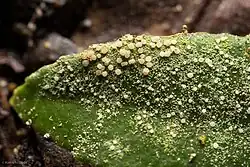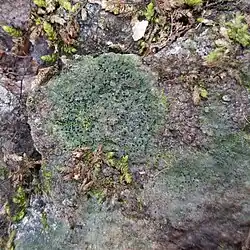Fellhanera
| Fellhanera | |
|---|---|

| |
| Fellhanera bouteillei | |
| Scientific classification | |
| Kingdom: | Fungi |
| Division: | Ascomycota |
| Class: | Lecanoromycetes |
| Order: | Lecanorales |
| Family: | Pilocarpaceae |
| Genus: | Vèzda (1986) |
| Type species | |
| Fellhanera fuscatula (Müll.Arg.) Vězda (1986)
| |
| Synonyms[1] | |
| |
Fellhanera is a genus of mostly leaf-dwelling lichens in the family Pilocarpaceae.[2] Established by the lichenologist Antonín Vězda in 1986 and named in honour of Austrian lichenologist Josef Hafellner, the genus comprises 63 accepted species as of 2025. These small lichens form powdery, crust-like growths that adhere tightly to their substrate without developing a true protective skin (a cortex), and they produce distinctive chemical compounds including roccellic acid and zeorin that help distinguish them from similar-looking genera.
Taxonomy
The genus, circumscribed by lichenologist Antonín Vězda in 1986,[3] honours Austrian lichenologist Josef Hafellner.[4]
Description
Fellhanera species form a crust-like thallus that adheres tightly to the substrate but never develops a true protective skin (cortex). When young the surface usually looks powdery or scurfy, ranging from whitish through grey-green to dull ochre, and may break into shallow wart-like bumps or irregular cracks as it matures. Some species produce minute soredia or blastidia—tiny, easily detached granules that propagate the lichen vegetatively—yet even these remain embedded in the soft, corticolous crust. The algal partner (photobiont) is a simple green chlorococcoid cell about 5–12 micrometres (μm) in diameter, and there is little or no distinct hypothallus, so the colony often merges imperceptibly into the bark or leaf it covers.
Fruiting bodies of Fellhanera lichens are small, stalkless apothecia that start flat and can become slightly domed; their discs may carry a delicate white bloom (pruina) and vary in colour from pale beige or yellow to dark brown. The rim of fungal tissue (true exciple) is built of rounded cells that can erode with age, leaving the disc exposed. Within, a clear hymenium reacts blue in iodine because each club-shaped ascus has an amyloid cap and coat; eight smooth, colourless ascospores are produced, usually divided by one to seven transverse walls (septa) and sometimes surrounded by a gelatinous sheath. Many specimens remain sterile in the field and instead develop plentiful immersed pycnidia—minute pustules whose gaping ostioles release tear-drop-shaped conidia. Chemically the genus is characterised by roccellic acid, zeorin and occasionally usnic acid or asemone; dropping acetone on a scrap of thallus on a microscope slide yields a tell-tale white ring of precipitated substances, a quick test that separates Fellhanera (chemically positive) from the look-alike genus Bacidina (chemically negative).
Species
As of July 2025, Species Fungorum accepts 63 species of Fellhanera.[5]

- Fellhanera africana (Vězda) Lücking (2001)
- Fellhanera albidocincta (Vain.) Lücking (2001)
- Fellhanera antennophora Aptroot (2002)[6]
- Fellhanera atrofuscatula Herrera-Camp. & Lücking (2004)
- Fellhanera baeomycoides M.Cáceres & Aptroot (2017)[7]
- Fellhanera borbonica Sérus., van den Boom & M. Brand (2011)[8]
- Fellhanera bouteillei (Desm.) Vězda (1986)
- Fellhanera bullata Kalb & Vězda (1991)[9]
- Fellhanera chejuensis Lőkös, S.Y.Kondr. & Hur (2013)
- Fellhanera christiansenii Sérus. & Vězda (1994)
- Fellhanera colchica (Vězda) Llop (2007)
- Fellhanera crucitignorum C.A.Morse & Ladd (2013)
- Fellhanera dominicana (Vain.) Vězda (1986)
- Fellhanera endopurpurea Hafellner & Vězda (1991)
- Fellhanera eriniae R.C.Harris & Lendemer (2009)
- Fellhanera fallax R.C.Harris & Lendemer (2009)
- Fellhanera flavostanhopeae Lücking & R.Sant. (2008)[10]
- Fellhanera fragilis (Vězda) Lücking & Kalb (2001)
- Fellhanera fuscatula (Müll.Arg.) Vězda (1986)
- Fellhanera granulosa R.C.Harris & Lendemer (2009)
- Fellhanera guatemalensis van den Boom (2014)
- Fellhanera gyrophorica Sérus., Coppins, Diederich & Scheid. (2001)
- Fellhanera hybrida R.C.Harris & Lendemer (2009)
- Fellhanera incolorata P.M.McCarthy & Elix (2017)
- Fellhanera ivoriensis Lücking & R.Sant. (2001)[11]
- Fellhanera laeticolor (Malme) Kalb (2016)
- Fellhanera mackeei Lücking & Hürl. (2001)
- Fellhanera maritima S.Y.Kondr., Lőkös & Hur (2013)
- Fellhanera mastothallina (Vain.) Lücking & Sérus. (2001)
- Fellhanera microdiscus (Vain.) Vězda (1986)
- Fellhanera minnisinkorum R.C.Harris & Lendemer (2009)
- Fellhanera montesfumosi R.C.Harris & Lendemer (2009)
- Fellhanera naevia (Vain.) Lücking & M.Cáceres (2001)
- Fellhanera naevioides Lücking, B.Moncada & Álvaro (2023)[12] – Colombia
- Fellhanera nashii van den Boom (2004)
- Fellhanera obscurata Herrera-Camp. & Lücking (2004)
- Fellhanera ochracea Sparrius & Aptroot (2000)
- Fellhanera parvula (Vězda) Vězda (1986)
- Fellhanera pluviosilvestris P.M.McCarthy & Elix (2019)[13] – Australia
- Fellhanera punctata Lücking (2008)[10]
- Fellhanera rhaphidophylli (Rehm) Vězda (1986)
- Fellhanera robusta P.M.McCarthy & Elix (2017)[14]
- Fellhanera rubrolecanorina A.B.Peña & Colín (2004)
- Fellhanera semecarpi (Vain.) Vězda (1986)
- Fellhanera silhouettae Aptroot & Seaward (2004)[15] – Seychelles
- Fellhanera silicis R.C.Harris & Ladd (2009)[16]
- Fellhanera stictae Etayo (2017)
- Fellhanera stipitata Weerakoon & Aptroot (2016)[17] – Sri Lanka
- Fellhanera submicrommata (Vězda) Lücking & Kalb (2001)
- Fellhanera subtilis (Vězda) Diederich & Sérus. (1990)
- Fellhanera tasmanica Lücking & Elix (2001)[18] – Australia
- Fellhanera termitophila Aptroot & M.Cáceres (2013)[19] – Brazil
- Fellhanera tricharioides Lücking & R.Sant. (2008)[10]
- Fellhanera tropica Elix (2008)
- Fellhanera tubulifera Rain.Schub. & Lücking (2003)[20] – Costa Rica
- Fellhanera verrucifera Lücking (1997)
- Fellhanera viridisorediata Aptroot, M.Brand & Spier (1998)
References
- ^ "Synonymy: Fellhanera Vězda, Folia geobot. phytotax. 21(2): 200 (1986)". Species Fungorum. Retrieved 2 April 2021.
- ^ Wijayawardene, Nalin; Hyde, Kevin; Al-Ani, Laith Khalil Tawfeeq; Somayeh, Dolatabadi; Stadler, Marc; Haelewaters, Danny; et al. (2020). "Outline of Fungi and fungus-like taxa". Mycosphere. 11: 1060–1456. doi:10.5943/mycosphere/11/1/8. hdl:10481/61998.
- ^ Vězda A. (1986). "Neue Gattungen der Familie Lecideaceae s. lat. (Lichenes)" [New genera of the family Lecideaceae s. lat. (Lichenes)]. Folia Geobotanica et Phytotaxonomica (in German). 21 (2): 199–219. doi:10.1007/BF02854668.
- ^ Hertel, Hannes; Gärtner, Georg; Lőkös, László (2017). "Forscher an Österreichs Flechtenflora" [Investigators of Austria's lichen flora] (PDF). Stapfia (in German). 104 (2): 1–211.
- ^ "Fellhanera". Catalogue of Life. Species 2000: Leiden, the Netherlands. Retrieved 8 July 2025.
- ^ Aptroot, A. (2002). "New and interesting lichens and lichenicolous fungi in Brazil" (PDF). Fungal Diversity. 9 (1): 15–45.
- ^ da Silva Cáceres, Marcela Eugenia; Aptroot, André (2017). "Lichens from the Brazilian Amazon, with special reference to the genus Astrothelium". The Bryologist. 120 (2): 166–182. doi:10.1639/0007-2745-120.2.166.
- ^ Lumbsch, H.T.; Ahti, T.; Altermann, S.; De Paz, G.A.; Aptroot, A.; Arup, U.; et al. (2011). "One hundred new species of lichenized fungi: a signature of undiscovered global diversity". Phytotaxa. 18 (1): 54–55. Bibcode:2011Phytx..18....1L. doi:10.11646/phytotaxa.18.1.1. hdl:11336/4198.
- ^ Vězda, A.; Kalb, K. (1991). "Beiträge zur Kenntnis der foliikolen Flechten australischer Regenwälder III" [Contributions to the knowledge of foliicolous lichens of Australian rainforests III]. Nova Hedwigia (in German). 53: 215–228.
- ^ a b c Lücking, Robert (2008). Foliicolous Lichenized Fungi. Flora Neotropica. Vol. 103. New York: New York Botanical Garden Press. ISBN 978-0-89327-491-7.
- ^ Lücking, Robert; Santesson, Rolf (2001). "New species or interesting records of foliicolous lichens. VIII. Two new taxa from tropical Africa, with a key to sorediate Fellhanera species". The Lichenologist. 33 (2): 111–116. Bibcode:2001ThLic..33..111L. doi:10.1006/lich.2001.0312.
- ^ Lücking, Robert; Álvaro-Alba, Wilson Ricardo; Moncada, Bibiana; Marín-Canchala, Norida Lucia; Tunjano, Sonia Sua; Cárdenas-López, Dairon (2023). "Lichens from the Colombian Amazon: 666 taxa including 28 new species and 157 new country records document an extraordinary diversity". The Bryologist. 126 (2): 242–303. doi:10.1639/0007-2745-126.2.242.
- ^ McCarthy, P.M.; Elix, J.A. (2019). "A new saxicolous species of Fellhanera (lichenized Ascomycota, Pilocarpaceae) from eastern New South Wales, Australia" (PDF). Australasian Lichenology. 85: 3–7.
- ^ McCarthy, P.M.; Elix, J.A. (2017). "Five new lichen species (Ascomycota) and a new record from southern New South Wales, Australia". Telopea. 20: 333–353. Bibcode:2017Telop..20..335M. doi:10.7751/TELOPEA12043.
- ^ Seaward, M.R.D.; Aptroot, A. (2004). "Four Seychelles lichens new to science". The Lichenologist. 36 (2): 119–124. Bibcode:2004ThLic..36..119S. doi:10.1017/S002428290401401X.
- ^ Harris, R.C.; Lendemer, J.C. (2009). "The Fellhanera silicis group in eastern North America". Opuscula Philolichenum. 6: 157–174. doi:10.5962/p.381978.
- ^ Weerakoon, Gothamie; Wolseley, Patricia A.; Arachchige, Omal; Eugenia da Silva Cáceres, Marcela; Jayalal, Udeni; Aptroot, André (2016). "Eight new lichen species and 88 new records from Sri Lanka". The Bryologist. 119 (2): 131–142. doi:10.1639/0007-2745-119.2.131.
- ^ Lücking, Robert; Streimann, Heinar; Elix, John A. (2001). "Further records of foliicolous lichens and lichenicolous fungi from Australasia, with an updated checklist for continental Australia". The Lichenologist. 33 (3): 195–210. Bibcode:2001ThLic..33..195L. doi:10.1006/lich.2000.0316.
- ^ Aptroot, André; Cáceres, Marcela Eugenia da Silva (2014). "New lichen species from termite nests in rainforest in Brazilian Rondônia and adjacent Amazonas". The Lichenologist. 46 (3): 365–372. Bibcode:2014ThLic..46..365A. doi:10.1017/S0024282913000340.
- ^ Schubert, R.; Lücking, R.; Lumbsch, H.T. (2003). "New species of foliicolous lichens from "La Amistad" Biosphere Reserve, Costa Rica". Willdenowia. 33 (2): 459–465. Bibcode:2003Willd..33..459S. doi:10.3372/wi.33.33220.